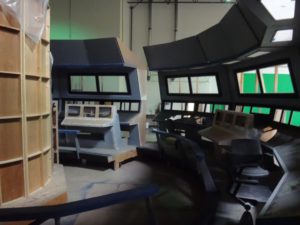By now, you’re probably aware of the breaking news. CBS and Paramount have settled their lawsuit with Axanar writer/producer, Alec Peters. Today, we discuss with Peters how this Kickstarter fan film evolved into a major sci fi film production. Plus, we cover the story of how CBS/Paramount came to sue, and what Peters and his team are planning now that the lawsuit is over.
When you looked at developing Axanar originally, you started with a Kickstarter campaign. Your ambitions in terms of scale were small. Tell us where you started out in your Kickstarter fundraising and how it all grew.

Set of Axanar / photo credit: Eric Mark
Originally Axanar was to be shot on the stages of Star Trek New Voyages. We were going to re-dress those sets and use them. We budgeted around a quarter of a million dollars, which was way more than any fan film.
Then Star Trek Renegades came out, and they raised around $380,000. We thought if that’s how much they’re doing, we better plan on raising about $350,000 ourselves.
We put together a Kickstarter video that was about 3 minutes long and started a campaign asking for $10,000. We wound up raising around $101,000. All told, including everything we have done to date, Prelude to Axanar has probably cost closer to $150,000.
How did fans react to Prelude to Axanar?
It’s won 47 film festival awards. The amount of people in love with it is just crazy. We created something special, and I mean our whole team. Rob Burnett played a huge role in Prelude to Axanar and then the Vulcan scene in Axanar. And there are so many others. You need this huge team (to make it all happen).
What made you aim higher than your original goals for the movie?

Klingon warlord Kharn (Richard Hatch)
Prelude set a bar that was very high. It was something that looks like it came out of the studio. It doesn’t look like a fan film. So we couldn’t just deliver a fan film; we had to deliver a fan film on steroids. As we went along, being that quality was the most important element, we kept raising our sights and finding bigger and better ways to do things.
How do those higher expectations impact the making of a fan film?
I always say there’s three kinds of fan films. First, there are fan films that look like home movies, and that’s great.
Then there are works such as Star Trek New Voyages or Star Trek Continues. They look really good; they’re very well done. The sets and effects are great. You have some professionals and some amateurs, but they’re worthy efforts.
Then you have films like Star Trek Renegades that try to be cinema quality. There are great examples of that in fan films.There’s Dirty Laundry, the Punisher fan film with Thomas Jane which is amazing, by Adi Shankar who also did Power/Rangers.

USS Enterprise in “Prelude to Axanar”
There are amazing fan films that look like they belong in Hollywood, and that’s because of the state of the art of filmmaking. We’re not shooting on film anymore. you can rent a RED camera for $500. Digital effects are inexpensive and easy these days, so it’s a lot easier to make something that looks amazing.
Axanar was riding the bleeding edge of this wave of filmmaking. So we kept raising our bar.
How did Axanar go from being a high-quality fan film to a problem that CBS and Paramount decided to sue over?
Ultimately, the quality of the Vulcan scene (the proof of concept for a feature-length Axanar film) is what got us in trouble. People say, “You raised too much money” or “You commercialized it.” It was none of those things. CBS saw the Vulcan scene and said, “This has gone too far. This is too good.”

The Vulcan Scene
The truth is, we would have given Axanar to CBS. We said to them, “Take it. Do what you want with it. We raised the money to make it. We made it. We’re not looking to make any money off this. Take it.” But they felt it was better to sue us. And so now here we are a year later.
Now that the lawsuit has been settled, what do you plan to do next?
First, we are having a big planning meeting with the core team to discuss our next steps. Out of that meeting will come an operational plan for the next steps in making Axanar. We will have to totally rewrite the script, but there should be no other major changes besides the fact that the movie is now two 15-minute segments and not a 90-minute feature.
What would you like to say to those who donated to the Kickstarter project, now that the lawsuit has been settled and Axanar will be made in some form?
Thank you! Most of the donors have been very supportive and loyal as we endured a 13-month lawsuit. We appreciate their patience and support. It really is what has kept us going. And it is who we do this all for!
I think when this is all done and Axanar has come out in some form, donors are going to be really happy. They won’t have gotten what they wanted, but they’ll have gotten something really special, and we’ll have fulfilled all the perks. And there we are.
(If you haven’t read part 1 of this interview yet, you can find it here.)